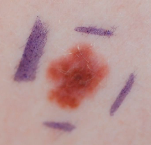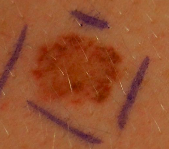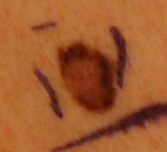Atypical (or Dysplastic) Moles

Atypical or dysplastic moles are a type of benign mole (see photo above). A mole (or nevus) is a benign growth of cells that produce pigment in the skin called melanocytes. An atypical or dysplastic mole is one that often looks different clinically and, when biopsied, has atypical features under the microscope; hence it is called atypical due to the irregular or unusual features. However, an atypical mole is not cancerous, a pre-melanoma or melanoma; but rather, a benign mole with an atypical architecture and cellular appearance under the microscope.
How is an atypical mole found?
An atypical mole often looks unusual and different in appearance from your other moles. It can appear anywhere on the skin from the scalp to the feet and may occur in children, but is more commonly seen in adults. Since it can be difficult to determine if a suspicious mole is simply atypical or a possible melanoma by only its appearance, your Dermatologist may recommend the lesion is biopsied to ensure it is not a dangerous cancer.
Photos of atypical moles:


What is the treatment for an atypical mole?
If biopsied, the Dermatologist will obtain a pathology report concerning the mole. The pathology report will indicate whether the lesion is an atypical (or dysplastic) mole or a different diagnosis, such as a common mole or melanoma.
Once diagnosed as an atypical mole, the Dermatologist will discuss the options which include either monitoring the lesion along with your other moles or removal of the lesion. If the pathology report indicates the atypical mole is severely atypical or possesses other concerning features, the Dermatologist will discuss the possible removal of the entire lesion to ensure it is completely removed and provide more tissue to confirm the diagnosis.
What does an atypical mole mean?
An atypical mole is considered a risk factor for melanoma. However, an atypical mole in itself is benign and studies have shown no significant increased risk of an atypical mole transforming to a cancer than any of your other moles. If you have a history of atypical moles and other risk factors, such as a personal history of melanoma, a first-degree relative with a history of melanoma, or more than 4 or more atypical moles, then you are at a higher risk for melanoma.
What should I do if I have a history of atypical moles?
If you have a history of atypical moles and possibly other risk factors (as discussed above), it is recommended to practice good sun-protection/sunscreen use daily, perform periodic self-skin exams and have periodic skin exams by your Dermatologist. . When performing a self-skin exam, it is a good technique to use the ABCDE’s to evaluate for possible melanoma or concerning lesions. The ABCDE’s of melanoma stand for Asymmetry; Border; Color; Diameter and Evolving.
If you have numerous moles, it is often beneficial to take photos of your skin with a camera to help evaluate your moles during your periodic self-skin exams. Your Dermatologist may also be able to assist with Total Body Mole Photography, which can assist you in checking your moles. If you do notice any changes or concerns regarding your moles, then see your Dermatologist as soon as able to have them evaluated.
What is the “Bottom Line” on atypical moles?
Atypical or dysplastic moles are benign moles that have unique features under the microscope and often appear different clinically; but they are not melanoma or a precursor to melanoma. If you have atypical moles, especially multiple ones, then you have an increased risk of developing melanoma compared to someone who does not have atypical moles. This increased risk does not mean you will get melanoma, but means to should closely watch the old and any new moles, along with the periodic skin exam by your Dermatologist.
